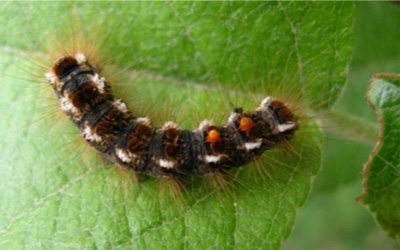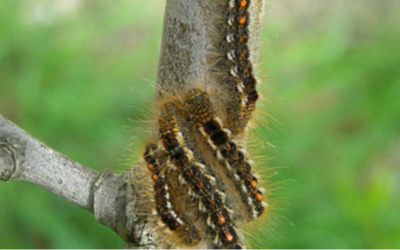Maine Residents Fend Off Poisonous Caterpillars
The caterpillars, known as browntail moths, have tiny hairs that can cause skin rashes and even breathing issues for some people.
By Jesus Jiménez
June 13, 2021
...
Browntail moths are most common along Maine’s coast and on Cape Cod, but they’ve been spotted this year in all of Maine’s 16 counties, said Jim Britt, a spokesman for the Maine Department of Agriculture, Conservation and Forestry.
“People are finding them everyplace: on the ground, on the picnic table, on the electrical box, on the corner — you name it,” Mr. Britt said. “They are heavily present. Folks will see them all over.”
“We are in the midst of an outbreak,” he said.
...
In Waterville, Maine, a city about 20 miles north of Augusta, the caterpillar infestation has gotten so out of control that the mayor called an emergency meeting of the City Council to declare a public health emergency and order insecticide.
“After a pandemic year, while we are finally able to start getting out and socializing, this is the last thing we want to be dealing with,” the mayor, Jay Coelho, said at the meeting, adding that he had received several emails from Waterville residents with pictures of painful rashes.
...
-------------------------------------------------------------------------------------------------------------------------------------------------------
Browntail Moths
On this page:
General Information
The browntail moth is an invasive species found only on the coast of Maine and Cape Cod. This moth is an insect of both forest and human health concern.
The browntail moth caterpillar has tiny poisonous hairs that cause dermatitis similar to poison ivy on sensitive individuals. People may develop dermatitis from direct contact with the caterpillar or indirectly from contact with airborne hairs. The hairs become airborne from either being dislodged from the living or dead caterpillar or they come from cast skins with the caterpillar molts. Most people affected by the hairs develop a localized rash that will last for a few hours up to several days but on some sensitive individuals the rash can be severe and last for several weeks. The rash results from both a chemical reaction to a toxin in the hairs and a physical irritation as the barbed hairs become embedded in the skin. Respiratory distress from inhaling the hairs can be serious.
Caterpillars are active from April to late June. Hairs remain toxic throughout the summer but get washed into the soil and are less of a problem over time.
 Close-up view of Browntail moth caterpillar on a leaf.
Close-up view of Browntail moth caterpillar on a leaf. Close-up view of Browntail moth caterpillars on a tree.Public Health Nuisance
Close-up view of Browntail moth caterpillars on a tree.Public Health Nuisance
Pursuant to Maine Statute Title 22, §1444 the Director of Maine CDC can declare an infestation of browntail moths (BTM) as a public health nuisance*. The declaration may be made on the Director's initiative or upon petition by municipal officers. Below is the process for declarations made upon petition by a municipality.
A. Municipalities
Should a municipality wish to petition for a public health nuisance declaration the process is as follows:
* A public health nuisance is defined as any activity or failure to act that adversely affects public health. Examples include improperly stored solid waste such as rotting garbage or dead animals, or insect or rodent infestations.
Resources for Maine Residents
Contact 211 Maine for more information on browntail moths:
The caterpillars, known as browntail moths, have tiny hairs that can cause skin rashes and even breathing issues for some people.
By Jesus Jiménez
June 13, 2021
...
Browntail moths are most common along Maine’s coast and on Cape Cod, but they’ve been spotted this year in all of Maine’s 16 counties, said Jim Britt, a spokesman for the Maine Department of Agriculture, Conservation and Forestry.
“People are finding them everyplace: on the ground, on the picnic table, on the electrical box, on the corner — you name it,” Mr. Britt said. “They are heavily present. Folks will see them all over.”
“We are in the midst of an outbreak,” he said.
...
In Waterville, Maine, a city about 20 miles north of Augusta, the caterpillar infestation has gotten so out of control that the mayor called an emergency meeting of the City Council to declare a public health emergency and order insecticide.
“After a pandemic year, while we are finally able to start getting out and socializing, this is the last thing we want to be dealing with,” the mayor, Jay Coelho, said at the meeting, adding that he had received several emails from Waterville residents with pictures of painful rashes.
...
-------------------------------------------------------------------------------------------------------------------------------------------------------
Browntail Moths
On this page:
General Information
The browntail moth is an invasive species found only on the coast of Maine and Cape Cod. This moth is an insect of both forest and human health concern.
The browntail moth caterpillar has tiny poisonous hairs that cause dermatitis similar to poison ivy on sensitive individuals. People may develop dermatitis from direct contact with the caterpillar or indirectly from contact with airborne hairs. The hairs become airborne from either being dislodged from the living or dead caterpillar or they come from cast skins with the caterpillar molts. Most people affected by the hairs develop a localized rash that will last for a few hours up to several days but on some sensitive individuals the rash can be severe and last for several weeks. The rash results from both a chemical reaction to a toxin in the hairs and a physical irritation as the barbed hairs become embedded in the skin. Respiratory distress from inhaling the hairs can be serious.
Caterpillars are active from April to late June. Hairs remain toxic throughout the summer but get washed into the soil and are less of a problem over time.
 Close-up view of Browntail moth caterpillar on a leaf.
Close-up view of Browntail moth caterpillar on a leaf. Close-up view of Browntail moth caterpillars on a tree.Public Health Nuisance
Close-up view of Browntail moth caterpillars on a tree.Public Health NuisancePursuant to Maine Statute Title 22, §1444 the Director of Maine CDC can declare an infestation of browntail moths (BTM) as a public health nuisance*. The declaration may be made on the Director's initiative or upon petition by municipal officers. Below is the process for declarations made upon petition by a municipality.
A. Municipalities
Should a municipality wish to petition for a public health nuisance declaration the process is as follows:
- 1. The municipality must complete the BTM Public Health Nuisance Request Form (Word) on town letterhead.
- 2. A letter from the Maine Forest Service, documenting the infestation in the town, shall accompany the Request for a BTM Public Health Nuisance Request form.
- 3. The municipality must have a letter from their local health officer supporting the request.
- 4. The municipality should submit the documentation to Infectious Disease Epidemiology, Division of Disease Surveillance, Maine CDC by mail, fax, or e-mail
- a. Mailing Address: 11 State House Station, 286 Water Street, Augusta ME, 04333-0011
- b. Fax number: 207-287-6865
- c. E-mail address: disease.reporting@maine.gov
- 1. A copy will be made of the request upon receipt by Division of Disease Surveillance staff.
- 2. One copy will be submitted to the Director for review and signature; the second copy will be provided to the vectorborne epidemiologist, who will notify the Maine Forest Service (State Entomologist) of the request.
- 3. If approved, petitions submitted from January 1 to August 31 will expire on December 31 of the current year. Petitions submitted from September 1 to December 31 will expire on December 31 of the following year.
- 4. The form, indicating approval or denial and signed by the Maine CDC Director will be returned to the municipality via US mail.
* A public health nuisance is defined as any activity or failure to act that adversely affects public health. Examples include improperly stored solid waste such as rotting garbage or dead animals, or insect or rodent infestations.
Resources for Maine Residents
- Frequently Asked Questions (FAQ)
- Maine DACF Browntail moth brochure (PDF)
- Maine CDC Browntail moth factsheet (PDF)
- Maine Department of Agriculture, Conservation, and Forestry (DACF) browntail moth website

Contact 211 Maine for more information on browntail moths:
- Dial 211 (or 207-874-2211)
- Text your zip code to 898-211
- Email info@211maine.org
